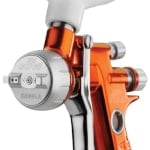|
|
|
Wet Film Combs
|
Elcometer has a wide selection of wet film combs from long edge combs to hexagonal combs through to punched aluminium combs.
Too much wet film can causes the coating to crack as it cures; too little coating increases the risk that the substrate will not be sufficiently protected, leading to rust spots.
Using a wet film comb
Place a comb perpendicular to and touching the substrate. Hole the comb in position and wait a few seconds until the teeth are wet. Remove the comb from the film.
The wet film thickness lies between the biggest value 'coated' or 'wet' tooth and the smallest value 'uncoated' or 'dry' tooth.
|
These reusable precision stainless steel combs are made to be long lasting and are supplied with either Metric or Imperial measurements. Four separate thickness ranges are available up to a maximum of 1270µm / 50mils and are manufactured to an accuracy of 5% or 2.5µm (0.01mil), whichever is the greater. Each comb has 10 measurement steps (teeth). Using a wet film comb Place a comb perpendicular to and touching the substrate. Hold the comb in position and wait a few seconds until the teeth are wet. Remove the comb from the film. The wet film thickness lies between the biggest value ‘coated’ or ‘wet’ tooth and the smallest value ‘uncoated’ or ‘dry’ tooth.
|
The Elcometer 154 Wet Film Combs are made from ABS plastic and are designed to be used once and kept as a record of wet film thickness measurement for quality assurance or customer requirements. Metric and Imperial values are on the same comb, 50 to 800µm on one side, 2 to 32mils on the other. Supplied in a pack containing 500 combs. Each comb has 16 measurement steps. Using a wet film comb Place a comb perpendicular to and touching the substrate. Hold the comb in position and wait a few seconds until the teeth are wet. Remove the comb from the film. The wet film thickness lies between the biggest value 'coated' or 'wet' tooth and the smallest value 'uncoated' or 'dry' tooth.
|
These stainless steel combs are wire eroded to provide an accuracy of ±2.5µm (0.01mil) and are supplied with either Metric or Imperial measurements. Each comb has 24 measurement stages (teeth) providing a more accurate wet film thickness value. Place a comb perpendicular to and touching the substrate. Hold the comb in position and wait a few seconds until the teeth are wet. Remove the comb from the film. The wet film thickness lies between the biggest value 'coated' or 'wet' tooth and the smallest value 'uncoated' or 'dry' tooth.
|
These punched aluminium combs offer the user a low cost method of measuring the wet film thickness. The Elcometer 112AL, being punched from aluminium, is not as accurate as precision formed, stainless steel wet film combs and has a shorter lifespan. Supplied in a pack of 10 combs, they have Metric units (25 - 3000µm) on one side and Imperial values (1 - 118mils) on the other. Using a wet film comb Place a comb perpendicular to and touching the substrate. Hold the comb in position and wait a few seconds until the teeth are wet. Remove the comb from the film. The wet film thickness lies between the biggest value 'coated' or 'wet' tooth and the smallest value 'uncoated' or 'dry' tooth.
|
These hexagonal precision formed stainless steel wet film combs are long lasting and reusable and are supplied in a range of thicknesses measuring up to 3000µm (120mils). These six sided combs vary in size, giving either 24 or 36 measurement steps, depending on the comb, providing increased accuracy. Using a wet film comb Place a comb perpendicular to and touching the substrate. Hold the comb in position and wait a few seconds until the teeth are wet. Remove the comb from the film. The wet film thickness lies between the biggest value 'coated' or 'wet' tooth and the smallest value 'uncoated' or 'dry' tooth.
|
|
|
|
|
|


















